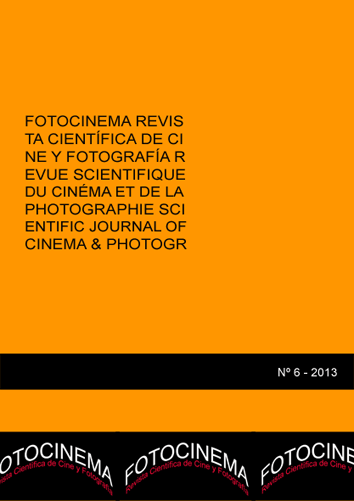Análisis fílmico de los juegos populares y tradicionales
DOI:
https://doi.org/10.24310/Fotocinema.2013.v0i6.5916Abstract
El análisis de escenas cinematográficas relacionadas con el ámbito lúdico, implica un estudio minucioso, por lo que hemos utilizado un diseño de estudio no experimental descriptivo que nos permitiera obtener el mayor número de datos para su posterior análisis de manera cualitativa, con lo que los resultados obtenidos han sido de una gran riqueza, a pesar de su subjetividad. Somos conscientes de la imposibilidad de localizar y analizar todos los juegos que aparecen en las películas y recogerlos en un solo trabajo.
El objetivo o meta principal que este proyecto, es servir de herramienta para los futuros docentes y profesionales de la educación, ofreciendo unas pautas adecuadas para utilizar el cine desde el punto de vista didáctico, y que se pueda convertir en un agente formativo. Hemos considerado prioritario una investigación basada en una experiencia innovadora y novedosa, incidiendo en la importancia de las nuevas tecnologías de la información y de la comunicación, así como la educación intercultural y en valores.
Palabras clave: Cine; juegos; educación; didáctica; imagen
The film scene analysis related to the field fun, involves a detailed study, so we used an experimental design not descriptive study that allowed us to obtain more data for further analysis in a qualitative manner, which results obtained have been of greater wealth in spite of its subjectivity. We understand the inability to locate and analyze all the games that appear in movies and collect them in a single job.
The objective or goal that this project is to provide a tool for future teachers and education professionals, offering appropriate guidance for using film from the educational point of view, and that can be converted into a training agent. We have considered a research priority based on an innovative and novel experience, stressing the importance of new information technologies and communication, and intercultural education and values.
Keywords: Cinema; games; education; educational; image
Downloads
Metrics
Downloads
Published
How to Cite
Issue
Section
License
All contents published in Fotocinema Revista científica de cine y fotografía are protected under the Creative Commons Attribution-NonCommercial-ShareAlike 4.0 International (CC BY-NC-SA 4.0) license. All about this license is available in the following link: <http://creativecommons.org/licenses/by-nc-sa/4.0>
Users can copy, use, redistribute, share and exhibit publicly as long as:
- The original source and authorship of the material are cited (Journal, Publisher and URL of the work).
- It is not used for comercial purposes.
- The existence of the license and its especifications are mentioned.
There are two sets of authors’ rights: moral and property rights. Moral rights are perpetual prerogatives, unrenounceable, not-transferable, unalienable, imprescriptible and inembargable. According to authors’ rights legislation, Fotocinema. Revista científica de cine y fotografía recognizes and respects authors moral rights, as well as the ownership of property rights, which will be transferred to University of Malaga in open access. The property rights are referred to the benefits that are gained by the use or the dissemination of works. Fotocinema. Revista científica de cine y fotografía is published in an open access form and it is exclusively licenced by any means for doing or authorising distribution, dissemination, reproduction, , adaptation, translation or arrangement of works.
Authors are responsable for obtaining the necessary permission to use copyrighted images.













13.png)




